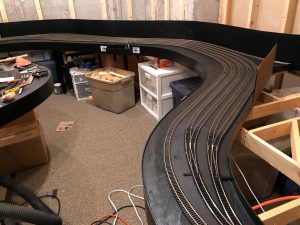It occurs to me that I’ve been sharing all these pictures that show pieces and parts of the staging level, but I’ve never shared a drawing showing the staging plan.
Staging takes up almost the entire space below the lower level. The notable exception is a large cabinet in one corner that houses tools and supplies and a narrow space next to the cabinet dedicated to the DCC command station, booster, and computer connection. Adjacent to the DCC command station (currently a Digitrax Zephyr Xtra) is a 19″ section of track separate from the layout for programming locomotives. This area also houses two short connected tracks for storing locomotives not in use for a given ops session–I figured this was better than handling them all the time.
The rest of the level contains the two staging yards for the Southern and L&N, respectively. Southern staging, representing Appalachia, VA, consists of three staging tracks on a reversing loop with tracks of 21+ feet. Inman represents the upper end of Appalachia Yard (as it did in real life), and I’m using this moniker to differentiate the “business end” of Appalachia from the reversing loop connection end. A forth track snakes around the reversing loop to form a continuous running connection on the other end of the layout where the helix goes up to St. Charles. I plan to use this to break in new locomotives and to entertain kids–in a pinch it can be used as a fourth Southern staging track.

Under St. Charles is a 4-track, stub ended staging yard for the L&N which represents Pennington, VA where the short Pennington Branch left the L&N’s Cumberland Valley main to connect with the Southern at Pocket, VA (technically L&N Jct), not far from St. Charles. L&N tracks are 13 1/2 feet long, plenty long for the single locomotive and short string of cars that usually plied these rails. Four tracks is about three too many, but this will allow some “fiddle staging” for less commonly used cars (e.g., boxcars) and hoppers from other eras.
Hope this helps to visualize things better!

Dan
Thanks I was trying to picture how all those tracks were arranged. Nice job.
Bill